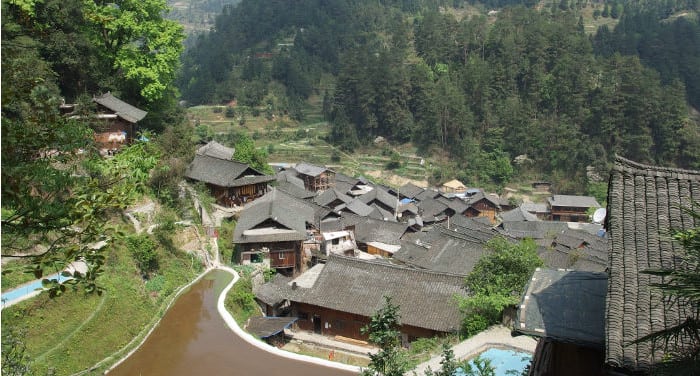
Located in the southeastern part of China, Guizhou Province is formed by rice paddies, soft hills full of terraces, villages that stand out of the clouds and the songs and colors of the minorities that populate the region.
Even though the province is considered one of the poorest in China, both from a gross internal product per capita point of view, as well as the condition of the numerous rural villages that compose it, it is still a source of pride for the Chinese. In fact, of the 55 ethnic minorities who live in the country that are considered an important resource by the Chinese people and government for their customs, dress and traditions, a good 18 ethic minorities live in Guizhou; and it’s therefore counted among the provinces with the most minorities!
Another source of pride for the province are the Huangguoshu waterfalls. Besides being the largest waterfall in Asia, it is said that from a rock of the falls Sun Wukong was born, symbol of classic Chinese literature and protagonist of traditional opera.
Why go to Guizhou
What Guizhou Province lacks is a large and modern metropolis, the capital Guiyang is neither a tourist destination nor a metropolis; so if you decide to travel in the province it is to immerse yourself in nature.
Letting yourself be captivated by the awesomeness of the small villages and attractive scenes in the eastern part of the province is one of the reasons I recommend that you travel to Guizhou, discovering the smiles and songs of the various ethnic minorities can’t help but do you good and make your trip all the more pleasant.
It doesn’t lack a historical part, and the old city of Qingyan, a military outpost of the Ming era won’t disappoint your expectations.
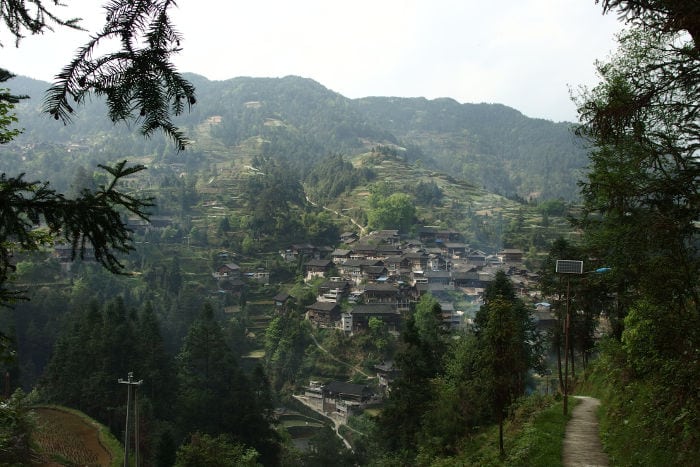
Guiyang, the capital of Guizhou
Not much different than the majority of Chinese provincial capitals, on first impression Guiyang will seem to be an anonymous city with giant Communist-style buildings and very messy yards everywhere. Despite this, if you travel to Guizhou I recommend that you pass through the city, which is the traffic hub if you decide to go to both the eastern and western part of the province, and isn’t far from the historic city of Qingyan.
One day is sufficient. Qianling Park (黔灵公园) is where the majority of the city’s attractions are concentrated: a cable car and a few temples.
Staying in Guiyang
If you’re a backpacker I recommend the hostel On the Way (在路上), run by really nice guys in the center of town; it’s very cheap, and if you book on Booking it costs an additional 10 Yuan, so for this I recommend that you call by phone to see if they have rooms available.
The areas near the main stations are full of hotels, so if you don’t want to go too far from the station to leave early the next day, then I recommend that you stay near the station.
Getting around from Guiyang
There are two main stations in Guiyang:
- The Central Station (贵阳火车站), is where slow trains leave, headed throughout the region and some that reach the bordering provinces;
- The North Station (贵阳北站), is the station where fast trains reach all the major cities from the south and central part of China. In addition, the high speed train line is slowly expanding through Guizhou as well, and because of this you’ll comfortably be able to reach all of the major attractions in the region in a maximum of an hour.
Visiting the old city of Qingyan
The city of Qingyan (青岩), which was founded during the Ming era, served as a military outpost, and is now known by the name Guzhen (古镇); the old city, like all other old cities in China don’t want for shops and activities to draw tourists.
The city is quite distinctive: the ancient restored walls surround it entirely, the winding paved alleys reach beautiful temples, among which I advise Yingxiang Temple (迎祥寺) and old houses. Among the alleyways you can even find a Catholic church!
Getting to Qingyan is very easy from Guiyang, if you find yourself at the central station you can take bus number 203 to the head of the line or you can also take a taxi for a price less than 100 Yuan; however ask the driver how much the ride will be before getting in the taxi.
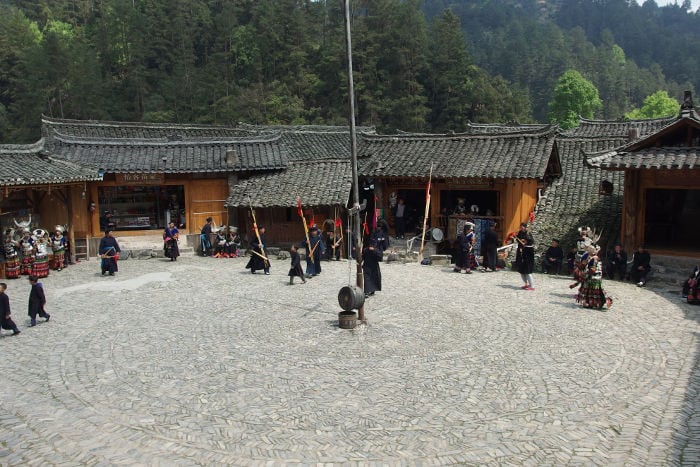
Eastern Guizhou: From Kaili to Congjiang, traveling among the ethnic minorities of Guizhou
The eastern part of the region is without a doubt the one that most deserves to be visited; it is populated by 18 different ethnic minorities and has seen development in the past twenty years, and for this is still rich in authenticity and at times deprived of every type of comfort.
This eastern part starts at the city of Kaili, not far from Guiyang, and covers an are that goes up to the northeastern border with Hunan Province, and the southeastern border with Guangxi Province. The majority of villages are located in the southern part, and for this reason I recommend that you go from Kaili to Congjiang.
Of the 18 ethnic minorities, the majority of people that you’ll meet will belong to the Miao (苗) or the Dong (侗), the others are mainly subgroups of these two main ones.
Useful advice
The area between Kaili and Congjiang is crossed by a high speed line, but if you decide to travel ‘slowly’, which I recommend since you’ll be passing through unique landscapes, you’ll need five days to a week to avoid being in a rush.
If you’re a fan of trekking, before your trip you’ll certainly come across reading material about trekking and paths through terraces and mountains, since these paths exist but aren’t at all marked; furthermore, the weather in this area changes quickly, so be careful before setting out for the mountains.
Even though in many villages you can pay by phone and credit card, this isn’t as widespread as in the rest of the country, so always keep cash in your wallet.
Arriving at Kaili and leaving for Langde
Kaili Station (凯里) is just outside the city enter, and on arrival many taxi drivers will be ready to sell you a trip to see the villages nearby. The majority will offer the village of Xijiang (西江), which I suggest that you skip since it is too touristy, and even the locals use the expression “tai kaifa” (too open).
Instead, head right for the village of Langde (郎德), but look well before taking a taxi, in fact the bus is much cheaper. Take bus n. 2 until the long distance bus station (凯里客车站); from there a bus leaves for Langde every hour.
Langde, like all other Miao villages is divided into two parts, the upper part, Shangzhai (上寨), and the lower part, Xiazhai (下寨).The prettiest part of Langde is the upper one, so tell the driver that you want to get off there (Shangzhai), and find a hotel.
Langde, Miao village between terraces and woods
Arriving in Langde you’ll find many people offering you a room. Personally I suggest staying at the Lancui (揽翠), a wooden inn that’s easy to find if you ask the elderly ones at the entrance of the village; a room for one person costs 50 Yuan a night. There’s a fee to enter the village, but after 1900 there’s nobody left at the ticket booth, so you can avoid paying the fee to get inside.
After having been woke up by the sound of roosters, I suggest that you have a noodle breakfast from one of the many ladies you’ll find in the village, to then tour through the woods and terraces that you’ll find going up above the village. At 10:30 a show composed of Miao minority dance and song begins, which is held in the village’s main square; just follow the music to find it. In the square you’ll also find a museum about Miao customs.
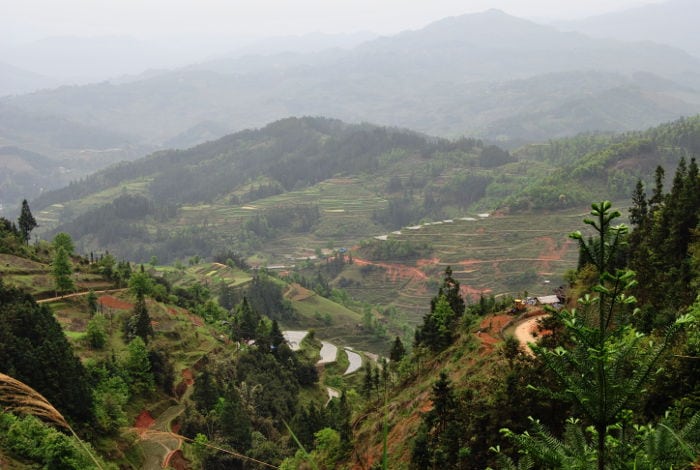
Trekking around Langde
Once leaving Langde the destination will be Leishan (雷山), which you can reach by trekking, taking the bus or asking the old men of the village for a ride.
There are many trekking options that leave from Langde, the most popular leave from the lower part of the village, where some paths wind along the river, crossing many other villages.
If instead you want to get to Leishan on foot, go in the opposite direction, toward Baode (报得), which is a few hours from Langde and from which paths will allow you to reach Nanyun (南云) then Leishan. If you stop for a break in Baode keep in mind that you’ll can only pay in cash.
Arriving at Leishan and the long trip to Congjiang
In any way you decide to get to Leishan I recommend that you go to the bus station to look for a place to stay there across from it, among the many hotels not all accept foreigners, but you’ll surely find someone disposed to give you a room. I suggest that you stay nearby because the next day’s trip to Congjiang will be very demanding, and you’ll need an entire day.
The first stop is the city of Rongjiang (榕江), which you can reach by bus from Leishan. The bus takes four hours and there are two runs a day, at 9 and 1400. A ticket costs 45 Yuan and the ticket counter in Leishan accepts only cash. You’ll reach Rongjiang by passing through small villages and stupendous landscapes, perhaps the most beautiful I’ve seen in the whole region. Arriving at Rongjiang take the bus for the train station; it’s n. 5 and you need to get off at the end of the line.
Trains leave Rongjiang every 15 minutes for Congjiang, and they take a little more than a half hour. Once you get to Congjiang Station, you’ll still need another hour by bus to get to the middle of town.
Congjiang, Miao and Dong prefecture
There are numerous villages in Congjiang County, and to see a good portion of it, I suggest that you stay in the area for at least two days. The villages can be easily reached from Congjiang, so for sleeping, finding a hotel in Congjiang can be an excellent choice so as not to risk having to pay for an expensive room in the villages.
Congjiang is a Miao and Dong prefecture; ethnic Miao villages are found in the southern part of the county, while the Dong are in the north.
First day in Congjiang: Basha, the village of the Miao warriors
Among the Maio villages around Congjiang is Basha (芭莎) and it is without a doubt the most famous and characteristic. What makes it so original are its extravagant inhabitants, warriors with ponytails similar to those of the Manchurian era, a knife attached to their belt and a loaded rifle filled with blanks always on their shoulder.
Considered the last Chinese tribe of warriors, the inhabitants of Basha have prospered from the conspicuous number of tourists that come to the village, and this is easily seen from the price of a ticket (70 Yuan) that you need to pay to enter the village and see the show. However, they still remain a tribe of hunters – you might see them return from the woods with a dirty knife and game in their arms.
The village can be reached by bus from the center of Congjiang, and then you have to take a shuttle, but I suggest that you go on foot for two reasons: the road from Congjiang to Basha follows the course of the river, and there’s no shortage of markets and wonderful scenes of everyday life; and there’s also because if going on foot, just before the entrance and ticket booth for Basha, if you go down toward lower Basha (芭莎下寨) you can then get into Basha without going through the ticket counter and save yourself 70 Yuan!
Caution: if you enter Basha this way, avoid going to see the show because someone will pass to check your ticket and this might cause you problems.
Something you absolutely have to try is the strange hamburger of Basha (or Biasha in the local dialect), the bread is substituted by two layers of rice and in the middle there’s an exquisite slice of grilled bacon.
Another Miao village near Basha is Wangjia (王家).
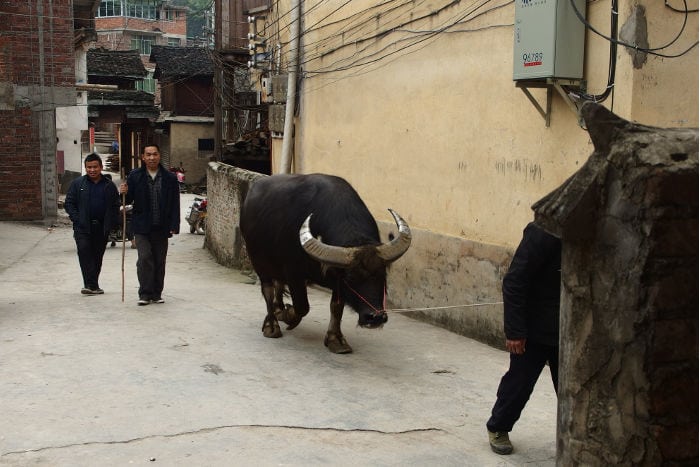
Second day in Congjiang: visiting the ethnic Dong villages
To the north of Congjiang there’s a series of beautiful Dong villages perched on splendidly lush hills that can be easily reached by taking bus n. 3.
Get off at the Pingqiu stop (坪求) and start your visit by leaving from the village of the same name. The first thing that will jump out at you when entering a Dong village is a tower placed at the center, called Gulou (鼓楼) which represents the heart of the village. In fact, seated in and around the tower you will see lots of elderly people lost in their conversations.
Inside the tower you’ll see a stall, with each stall containing a yak with shiny black hair and many older ones that take care of it. The reason is because one of the most characteristic customs of the Dong is yak fighting (斗牛), and you’ll be fortunate if you can see one of these fights that are held twice a months in different villages.
Leaving the village of Pingqiu, continue toward Gaozeng (高增), and once past Gaozeng the road scrambles between hills and steep climbs. Considering the distances involved in reaching the other villages, try to get a ride to Gaozeng or try hitchhiking. It was easy for me to get a ride!
Once you’ve got a ride, don’t miss the villages of Bapa (芭扒) and Xiaohuang (小黄), and lastly there’s the famous Dong village of Zhaoxing (肇兴); I have to warn you that Zhaoxing is to the Dong what Xijiang is to the Miao, so it’s up to you to decide if you want to visit this super touristy village.
Getting around from Congjiang
Congjiang’s modern station is crossed by high speed train lines; if you have to go back you can get to the north station of Guiyang in an hour and a half, or many continue their trip moving on to famous Guilin, which is only an hour away and costs 43 Yuan for a high speed train.
Huangguoshu Falls, between myth and spectacular landscapes
The Huangguoshu Falls are the largest in all of Asia, and are spread over an area of about 450 square kilometers rich in waterways, caves and karst formations. This makes Huangguoshu Falls without a doubt the largest natural attraction in the region, and if the flora doesn’t disappoint then the fauna certainly won’t. Numerous animals can be found among the falls – don’t miss seeing the numerous peacocks around Rhinoceros Lake (犀牛潭).
There are also many trekking choices in the area, with also the provision of tourist buses to allow those with less time to see the most of the natural park.
Making the falls even more alluring is the myth of Sun Wukong, the famous monkey protagonist of the novel “Travel in the West” which legend says was born from a rock near one of the falls.
How to get to the falls
To get to the falls there are buses that leave from Guiyang, both from the bus and train stations, and they take from two to two and a half hours. Or much more convenient is reaching the falls from the nearby city of Anshun (安顺), where buses leave every twenty minutes but from where you can also take a taxi for a decent price.
Photo Credits: Photos by Gianluca Falso



